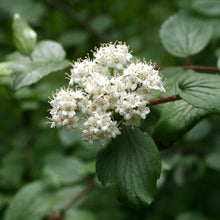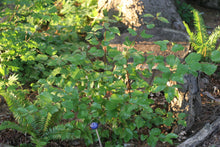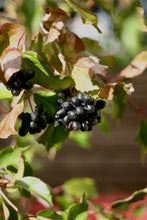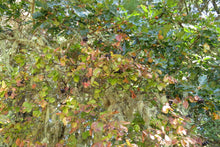
Viburnum ellipticum
Oval-leaved viburnum is a large native shrub that provides excellent wildlife habitat and three-season visual appeal. Attractive clusters of small white flowers appear in mid-spring, providing nectar to butterflies and bees. True to the name, the leaves are oval to round-shaped and bright glossy green throughout the growing season, then transition to vibrant colors in fall. Its striking fall color is further accented by fruits that start out bright red or orange, turn blueish-black as the season progresses, and are a valuable source of food for migrating birds.
- Plant type/canopy layer: deciduous perennial large shrub
- Size at maturity: 6-10' tall, 5-8' wide
- Light requirements: full sun, part sun/part shade
- Moisture requirements: dry to moist soil, well-drained
- Bloom time: April - July
- Growth rate/ease: medium growth rate, easy to grow
- Wildlife support: flowers attract and provide nectar to adult butterflies, bees and other insect pollinators; berries provide food to songbirds; overall plant attracts and supports beneficial and other pest eating insects, is a caterpillar host plant/larval food source, and provides excellent cover and refugia habitat for birds and small mammals
- Native habitat/range: locally common in the edges and openings of deciduous woods, along streams, and in chaparral, or shrub thickets mostly west of the Cascades from southwest WA to central CA, with a reported population in North Dakota. Portland Plant List - yes.
- Special features & uses: striking fall color; pollinator favorite; drought-tolerant; indigenous people made beads made from the fruit/seeds for thousands of years; landscape uses include pollinator gardens and woodland gardens, erosion control and hedgerows
Gardening with Oval-leaved Viburnum: It's unsurprising that this versatile, attractive large shrub is becoming more common in landscaping. Oval-leaved viburnum is able to thrive in partial to full sun and most any well-drained soil type, including occasional drought and flooding. As such, it functions quite well as a screen or as a foundational plant in pollinator gardens or open woodland gardens.
Photo Credits 1-3 (flower close, young plant, berries): Karli Del Biondo, Beetles and Bees
Photo Credit 4-6 (fall leaf color, fall with berries, flowering habit in wild): © Ed Alverson, some rights reserved (CC-BY)











